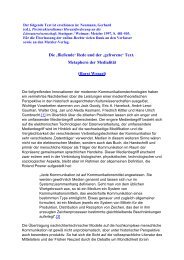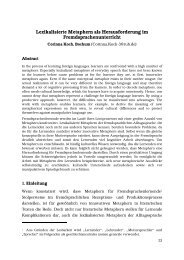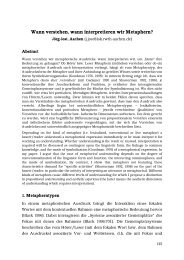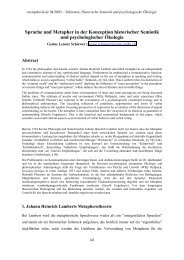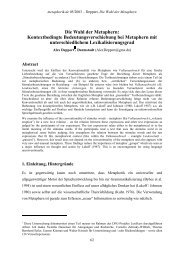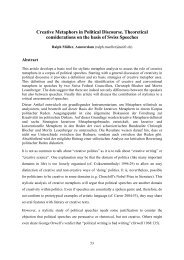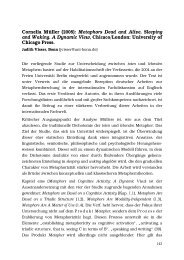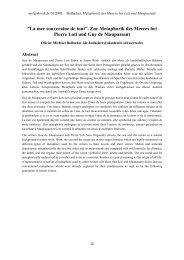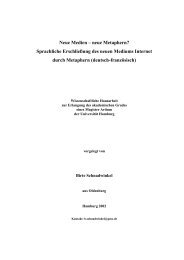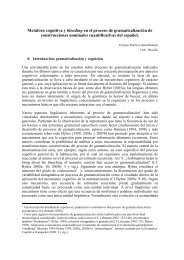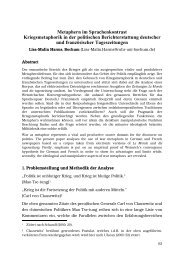The Sweet Smell of Red - An Interplay of ... - metaphorik.de
The Sweet Smell of Red - An Interplay of ... - metaphorik.de
The Sweet Smell of Red - An Interplay of ... - metaphorik.de
Create successful ePaper yourself
Turn your PDF publications into a flip-book with our unique Google optimized e-Paper software.
72<br />
<strong>metaphorik</strong>.<strong>de</strong> 18/2010<br />
the concordance line it is very easy to get a picture in the mind’s eye <strong>of</strong> a<br />
person wearing this kind <strong>of</strong> clothes, especially with the additional information<br />
<strong>of</strong> bright tie.<br />
A0U 2385 She was seen with a man in a loud checked suit who favoured<br />
bright ties.<br />
Very differently from all other sense-related adjectives is the fact that loud and<br />
laut do not seem to have a specific connotation. Of course, they can occur with<br />
rather dramatic words like scream, wail or cries etc. but those words are by<br />
themselves dramatic and not because <strong>of</strong> the combination with loud/laut. Loud<br />
in itself is neutral – it is never negative or positive without further information<br />
conveyed by the following noun. A quiet scream is not less terrifying as a loud<br />
scream can be. <strong>The</strong> quality <strong>of</strong> the sound is not changing the connotation, thus,<br />
loud is only additional information rather than carrying the connotation and<br />
therefore not important for the overall mood. A further indicator for this<br />
neutrality is that it can be combined with any kind <strong>of</strong> sound – negative or<br />
positive. It is not limited to the human voice, or music, or animal noises, or<br />
other noises and sounds.<br />
EA5 31 his sud<strong>de</strong>n exclamation <strong>of</strong> horror had started a loud wail and<br />
reduced Carrie to a fit<br />
H0F 1758 Perfectly preserved, and spoke in loud, happy voices.<br />
Ge 1993… Gedanken durch <strong>de</strong>n Kopf, wie ich beginnen wollte, da rief<br />
eine laute Stimme durch <strong>de</strong>n Saal …<br />
Generally speaking, both forms <strong>of</strong> loud/laut – the literal as well as the<br />
metaphorical one – have the function <strong>of</strong> conveying the i<strong>de</strong>a <strong>of</strong> something<br />
being noticeable. As the syntactic structure does not show any differences, it is<br />
in some cases rather difficult to say if a sentence really is metaphorical or not –<br />
the bor<strong>de</strong>r between metaphoricity and literal use is very small sometimes.<br />
6.2 quiet/leise<br />
<strong>The</strong>se two words behave very differently, not only in the number <strong>of</strong><br />
occurrences. Leise occurs 0.107 times within 1000 running words and thereby<br />
more <strong>of</strong>ten than most other terms that are analyzed and very differently from<br />
the English term quiet, which only occurs 0.060 times. While quiet shows no<br />
synaesthetic combinations and hardly any metaphorical occurrences (5), leise<br />
comes up almost 50% <strong>of</strong> the time as such and within these in two different



